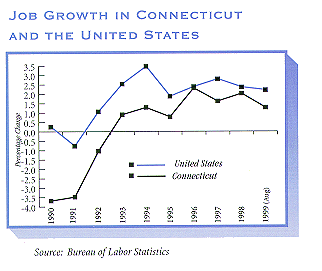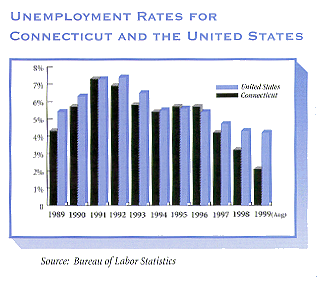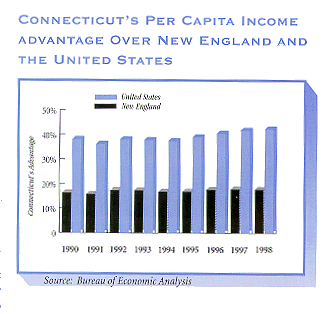

Over the past several years, Connecticut's economy, like the national economy, has been strong and growing. The state was slow to recover from a recession that began in the winter of 1989 and officially ended in December of 1992. Between 1993 and 1995 Connecticut realized little net job growth, experienced declining real family income, and saw rising poverty rates. During this period, Connecticut lagged far behind the national economy in overall economic performance. By 1996, the picture began to brighten for most state residents. Strong job gains, rising incomes, low inflation, and exceptional financial market performance have characterized the past three years. In 1997 and 1998, Connecticut outpaced national growth rates in several important economic measurements. Complete results were not available for 1999 at this writing.
Projections for the coming years show Connecticut continuing to experience economic growth, but at a more modest rate. Connecticut's labor markets are tight. Only 33,900 job seekers are presently unemployed, and labor force growth is stagnant. Therefore, opportunities for economic growth through future employment gains are limited. Tighter Federal Reserve Bank monetary policy, the potential for an overdue stock market correction, and global economic instability may combine to slow national and state economic growth. Nevertheless, with the dramatic economic growth of the past several years, and projections for moderate sustained growth in the future, Connecticut's overall economic outlook remains good.
 |
EMPLOYMENT | |
| During the past three years (1996-98), Connecticut's job gains have averaged just over 31,000 per year. Projections for 1999 show the state adding between 20,000 and 25,000 jobs. By November, the state had regained all of the jobs lost during the 1989-92 recession. | ||
| Immediately following the recession, Connecticut's employment gains lagged far behind those realized by the nation as a whole. From 1993 through 1995, employment growth in Connecticut averaged less than 1 percent, while the national average was over 2.5 percent. However, by 1996 Connecticut was seeing stronger job gains that approximated those of the national economy. | ||
| The lack of sustained growth in the available number of workers in Connecticut, which is related to the state's slow population growth, will limit the potential for large future job gains. Over the past five years, Connecticut has experienced two years of modest labor force gains offset by three years of work force losses. At the end of 1995, the state's labor force totaled 1,706,400. As of August 1999, the state labor force was virtually unchanged at 1,705,800. The national economy has experienced consistent labor force growth over the past decade. | ||
| The combination of a strong state economy and a stagnant labor force has left Connecticut with a historically low unemployment rate. In August 1999, the statewide unemployment rate was 2.1 percent; the national rate was 4.2 percent. Even Connecticut's urban areas, which traditionally maintained high rates of unemployment, have posted notable declines in the number of unemployed. Figures for the third quarter of 1999 show the following unemployment rates for Connecticut's largest cities: Bridgeport 4.4 percent; Hartford 4.6 percent; New Haven 3.0 percent; Stamford, 1.9 percent; and, Waterbury 3.5 percent. Almost half of Connecticut's 169 municipalities posted unemployment rates below 2 percent. |
| Over the past ten years there has been a
pronounced shift in the industries in which Connecticut workers are employed. In 1989,
21.3 percent of all Connecticut workers were employed in manufacturing; by 1999, the
number had dropped to 16.3 percent. The opposite trend has occurred in the service sector.
In 1989, services employed 25.9 percent of workers; by 1999, the number had increased to
31.7 percent. Throughout the decade, the combination of manufacturing, services, and
wholesale and retail trade have accounted for approximately 70 percent of all state
employment. It should be noted that gains in the governmental sector are largely due to
the inclusion of Indian gaming in this category.
|

|
|
| The broad service industry category includes the following subcategories: engineering and management services; technology and advanced business services; health care services; and educational services. | ||
| By most measurements, Connecticut consistently ranks as one of the top five high technology employment states. | ||
| The ten fastest growing occupations in the state are as follows: computer engineer; systems analyst; computer support specialist; financial sales; physical therapist; biological scientist; recreation attendant; social worker; home care aide; and medical assistant. | ||
| The state's labor force is highly educated with 32.7 percent of those over age twenty-five holding a college degree. Connecticut ranks number two in the country in this measure. With slower employment growth projected in future years, Connecticut will rely more heavily on the training of its labor force to generate the productivity gains necessary for economic growth. |

|
INCOME | |
| In 1998, as in past years, Connecticut ranked number one in the nation in per capita income. State per capita income for 1998 was $37,700. This was 17.8 percent above the New England region, and 42.4 percent higher than the per capita income for the nation. Throughout this decade, Connecticut's per capita income advantage over the nation has been trending upward. Over the past four years annual average state per capita income growth has been just over 5.5 percent, which is a full percentage point above the average national growth rate for the period. | ||
| While per capita personal income is a good indicator of growth in total state income over time, it tells little about how that income is distributed. A state can have a high per capita income with most of the wealth held by a small segment of the population. A better measurement when considering income distribution is median income. Connecticut ranks number four in the nation in median household income; however, by this measure Connecticut's comparative advantage over the nation as a whole has been declining over the last ten years. | ||
| Through the past decade, real (inflation adjusted) median household income in Connecticut has actually declined 15.7 percent from its peak level. In 1989 Connecticut had real median household income of $52,764. The figure for 1998 was $45,589. In part, this shift is explained by the state's loss of high paying manufacturing jobs. It is estimated that the manufacturing jobs lost paid almost 30 percent more than the jobs that replaced them. | ||
| After seven consecutive years of decline, state real median income has started to rise over the past two years. And, after lagging far behind the nation in real median income growth, Connecticut is now outperforming the United States. In 1997 Connecticut's real median income median income grew by 1.9 percent, and in 1998 it grew 3.1 percent. For the United States the growth rates were 1.5 percent and 2.7 percent respectively. | ||
| Connecticut's two-year average poverty rate for 1997-98 was 9 percent, the fifth lowest rate in the nation; however, child poverty in the state was 17 percent. It is estimated that 159,000 school aged children, or 24 percent of the school age population in Connecticut live in poverty. More alarming is the state's dramatic slide over the last ten years from having the second lowest child poverty rate to a national ranking of number 23. |
| OTHER ECONOMIC AND SOCIAL INDICATORS | |
| Connecticut's real (in 1992 dollars) Gross State Product for 1997, which is the last year of available data, increased a hefty 5.3 percent. The gain for 1998 is expected to be about 5 percent. | |
| The state has experienced strong growth in the housing market with new housing permits rising 9.1 percent in 1997 and 27.4 percent in 1998. The average price of an existing home was $137,800 in 1998, and is expected to increase by about 5 percent in 1999. | |
| Connecticut ranks second in the nation in average annual pay and teacher pay; fourth in per capita number of doctors; fifth in per capita mutual fund assets; 47th in the percent of births to teenage mothers; and 48th in the number of motor vehicle deaths per one hundred million vehicle miles. |